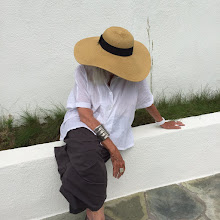Lyle Rexer on Marcia Lippman's work.
______________________________
Artists create their own precursors. Every work brings a history into being, a new path through the forest of the past. Borges tells us this in his essay on Kafka. But every work also creates its own geography, new maps that draw continents where there had been only islands. In Buenos Aires, you cannot place where you are. Is it New York, with its winter grayness and decaying infrastructure, its shedding plane trees? Certainly not an imperial capital like Madrid or a colonial capital like Mexico City. The absence of minorities is too glaring, the modernity too extensive, confirmed in the very fabric of its vast street grid. Horacio Coppola’s photograph of Corrientes Avenue at night, from the air, circa 1939, lit up like the Great White Way, conveys the flavor, the placeless self-confidence of a city without a past. Or maybe the opening shot of the miniseries Epitafios, a long overhead of moving traffic in Anywhereopolis, identifiable only by the fact that everyone in the show drinks Malbec.
When Marcia Lippman arrived in Buenos Aires, she wasn’t sure where she was, except in a place that looked familiar but was utterly strange. It is so much easier to take pictures in a place that is strange. You are relieved of the burden of knowing anything, of having to distinguish between the obvious and the intimate. There is an openness in which you discover yourself and where you imaginatively are. That sense of discovery is all over these pictures. She gave up her aestheticizing distance and opened herself to emanations, to pathos.
The pictures are details of something larger but never imaged, snatches of light in a foreign tomb. That’s the terrible secret of Buenos Aires, that it looks so modern but it is a city of the dead. Its famous cemeteries – Recoleta and Chacarita, are labyrinths, and Lippman, born a Catholic, raised a Jew, wandered there, looking for arrested time, broken sepulchers: a candelabra, like the ones often stolen from those very sepulchers, just as flowers are, for sale; a lace curtain, like those sold along with the piles of family silver in the flea market in San Telmo. A mortgaged past, mortgaged for a future that almost happened.
She did not go to La Tablada, the vast Jewish cemetery on the far outskirts for, above all, this was a Catholic journey. She had discovered her Catholic roots very late, because they were so deeply buried and denied. One of her pictures is a cross on a wall, divided between black and white, light and dark. This is the other secret of Buenos Aires: its primitive sanctity, its aura of devotion and violation. Broken sidewalks, broken tombs. Dog shit and dulce de leche.
The city was exposed to the visitor, and she exposed herself to it. She found that the city did not end when and where she left it, that it has the strange power to impose a geography that does not appear on any map. Sometime later Lippman was in Italy, and she found herself pursuing once again a visual itinerary of fragments, in a museum of shadows and frozen gestures. Roughly thirty-five percent of the population of Buenos Aires is descended from Italian immigrants, and the photographer had traveled the path of return, a reverse diaspora. She carried with her the strange tango-flower of Catholic longing, so apparently alien to the new Italy, and planted it there, in the soil of a bright northern Italy where shadows are bad memories, the southern affliction. But how did all those elaborate buildings get built and those overripe paintings get painted, if not out of the spirit that she discovered in Buenos Aires? And was not Leonardo’s great artistic innovation the sfumato, the revelation that it is not line and light that create volume but shadow? There is holiness even for the nonbeliever, especially for her, in Buenos Aires, capital of a new trans-oceanic nation named Caravaggio.
“There is an hour that makes the dusk your escort,” wrote the poet Paul Celan, thinking of a world like Lippman’s in which it is always twilight. The photographer used her last rolls of infra-red film for these pictures, and it feels almost sacramental, like the offering of some precious metal in hope of transubstantiation, a miracle. It is wholly appropriate that the properties of this film should never have been displayed so evocatively in her photographs until these final sequences, where subject and sensibility have united. Shadows are smoke. Light is liquid. The film itself passes out of its blank potential, passes away into its exposed and fixed form, into apparitional images. And the photographs seem not so much to record the world but to retrieve it from an encroaching dark, coax its last brilliance from a fading world.
Along with her film, the photographer herself passed out of one state and into another. That is what we see above all. Celan’s poem is about leavetaking, and Lippman in her arrival on a new continent is also taking leave. Or perhaps looking back, looking again. The paintings that appear so often in these photographs are not appropriations but reflections. The feet, hands and above all female breasts that the artist isolates form an inventory of self-examination. That is why the whole picture is not necessary, only those elements that the eye seeks and the heart needs. These beautiful fragments acknowledge the impulses behind devotion: desire and diminution, a sense of timelessness and the sense of an ending. They remind us that twilight, although it is always nearer than we think, allows us enough light to witness the body’s radiance.
-Lyle Rexer
Brooklyn, New York
